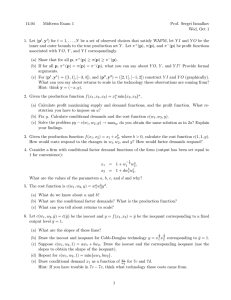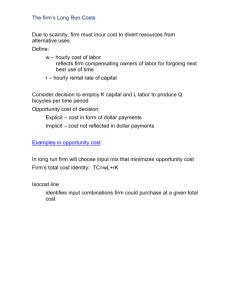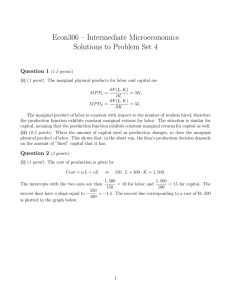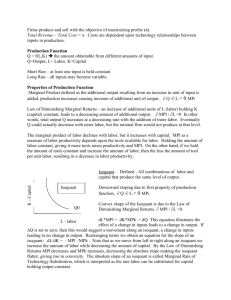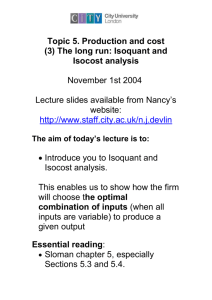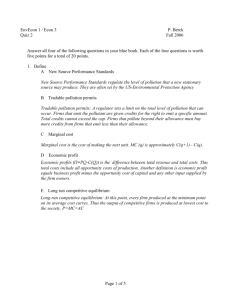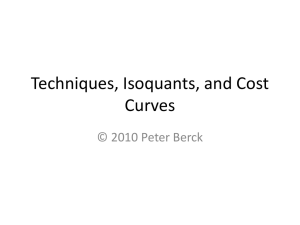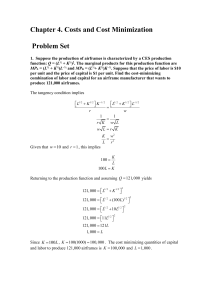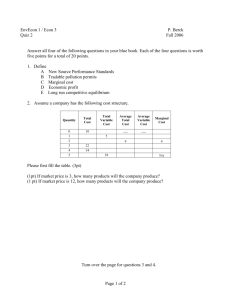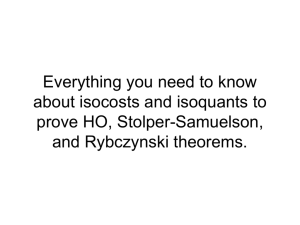Solution to Chapter 7
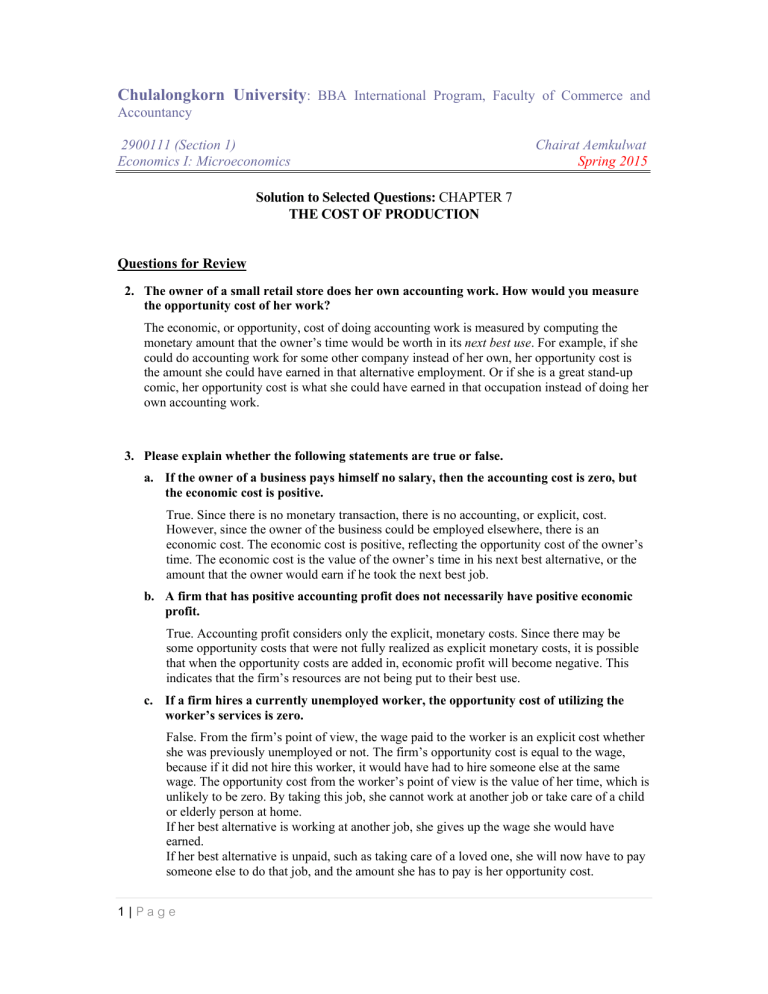
Chulalongkorn University
: BBA International Program, Faculty of Commerce and
Accountancy
2900111 (Section 1)
Economics I: Microeconomics
Chairat Aemkulwat
Spring 2015
Solution to Selected Questions: CHAPTER 7
THE COST OF PRODUCTION
Questions for Review
2. The owner of a small retail store does her own accounting work. How would you measure the opportunity cost of her work?
The economic, or opportunity, cost of doing accounting work is measured by computing the monetary amount that the owner’s time would be worth in its next best use . For example, if she could do accounting work for some other company instead of her own, her opportunity cost is the amount she could have earned in that alternative employment. Or if she is a great stand-up comic, her opportunity cost is what she could have earned in that occupation instead of doing her own accounting work.
3. Please explain whether the following statements are true or false. a. If the owner of a business pays himself no salary, then the accounting cost is zero, but the economic cost is positive.
True. Since there is no monetary transaction, there is no accounting, or explicit, cost.
However, since the owner of the business could be employed elsewhere, there is an economic cost. The economic cost is positive, reflecting the opportunity cost of the owner’s time. The economic cost is the value of the owner’s time in his next best alternative, or the amount that the owner would earn if he took the next best job. b. A firm that has positive accounting profit does not necessarily have positive economic profit.
True. Accounting profit considers only the explicit, monetary costs. Since there may be some opportunity costs that were not fully realized as explicit monetary costs, it is possible that when the opportunity costs are added in, economic profit will become negative. This indicates that the firm’s resources are not being put to their best use. c. If a firm hires a currently unemployed worker, the opportunity cost of utilizing the worker’s services is zero.
1 | P a g e
False. From the firm’s point of view, the wage paid to the worker is an explicit cost whether she was previously unemployed or not. The firm’s opportunity cost is equal to the wage, because if it did not hire this worker, it would have had to hire someone else at the same wage. The opportunity cost from the worker’s point of view is the value of her time, which is unlikely to be zero. By taking this job, she cannot work at another job or take care of a child or elderly person at home.
If her best alternative is working at another job, she gives up the wage she would have earned.
If her best alternative is unpaid, such as taking care of a loved one, she will now have to pay someone else to do that job, and the amount she has to pay is her opportunity cost.
Exercises
1. Joe quits his computer programming job, where he was earning a salary of $50,000 per year, to start his own computer software business in a building that he owns and was previously renting out for $24,000 per year. In his first year of business he has the following expenses: salary paid to himself, $40,000; rent, $0; other expenses, $25,000. Find the accounting cost and the economic cost associated with Joe’s computer software business.
The accounting cost includes only the explicit expenses, which are Joe’s salary and his other expenses: $40,000
25,000
$65,000. Economic cost includes these explicit expenses plus opportunity costs. Therefore, economic cost includes the $24,000 Joe gave up by not renting the building and an extra $10,000 because he paid himself a salary $10,000 below market ($50,000
40,000). Economic cost is then $40,000
25,000
24,000
10,000
$99,000.
4. Suppose a firm must pay an annual tax, which is a fixed sum, independent of whether it produces any output. a.
How does this tax affect the firm’s fixed, marginal, and average costs?
This tax is a fixed cost because it does not vary with the quantity of output produced.
If T is the amount of the tax and F is the firm’s original fixed cost, the new total fixed cost increases to TFC = T + F . The tax does not affect marginal or variable cost because it does not vary with output. The tax increases both average fixed cost and average total cost by T / q . b.
Now suppose the firm is charged a tax that is proportional to the number of items it produces. Again, how does this tax affect the firm’s fixed, marginal, and average costs?
Let t equal the per unit tax. When a tax is imposed on each unit produced, variable cost increases by tq and fixed cost does not change. Average variable cost increases by t , and because fixed costs are constant, average total cost also increases by t . Further, because total cost increases by t for each additional unit produced, marginal cost increases by t .
5. A recent issue of Business Week reported the following:
During the recent auto sales slump, GM, Ford, and Chrysler decided it was cheaper to sell cars to rental companies at a loss than to lay off workers. That’s because closing and reopening plants is expensive, partly because the auto makers’ current union contracts obligate them to pay many workers even if they’re not working.
When the article discusses selling cars “at a loss,” is it referring to accounting profit or economic profit? How will the two differ in this case? Explain briefly.
When the article refers to the car companies selling at a loss, it is referring to accounting profit. The article is stating that the price obtained for the sale of the cars to the rental companies was less than their accounting cost. Economic profit would be measured by the difference between the price and the opportunity cost of producing the cars. One major difference between accounting and economic cost in this case is the cost of labor. If the car companies must pay many workers even if they are not working, the wages
2 | P a g e
paid to these workers are sunk. If the automakers have no alternative use for these workers (like doing repairs on the factory or preparing the companies’ tax returns), the opportunity cost of using them to produce the rental cars is zero. Since the wages would be included in accounting costs, the accounting costs would be higher than the economic costs and would make the accounting profit lower than the economic profit.
9. The short-run cost function of a company is given by the equation TC = 200 + 55q, where TC is the total cost and q is the total quantity of output, both measured in thousands. a.
What is the company’s fixed cost?
When q = 0, TC = 200, so fixed cost is equal to 200 (or $200,000).
b.
If the company produced 100,000 units of goods, what would be its average variable cost?
With 100,000 units, q = 100. Variable cost is 55 q = (55)(100) = 5500 (or
$5,500,000). Average variable cost is
TVC q
$5500
100
$55, or $55,000.
c.
What would be its marginal cost of production?
With constant average variable cost, marginal cost is equal to average variable cost, $55 (or $55,000).
d.
What would be its average fixed cost?
At q = 100, average fixed cost is
TFC q
$200
100
$2 or ($2,000).
e.
Suppose the company borrows money and expands its factory. Its fixed cost rises by $50,000, but its variable cost falls to $45,000 per 1000 units. The cost of interest
(i) also enters into the equation. Each 1-point increase in the interest rate raises costs by $3,000. Write the new cost equation.
Fixed cost changes from 200 to 250, measured in thousands. Variable cost decreases from 55 to 45, also measured in thousands. Fixed cost also includes interest charges: 3 i . The cost equation is
TC = 250 + 45 q + 3 i .
10. A chair manufacturer hires its assembly-line labor for $30 an hour and calculates that the rental cost of its machinery is $15 per hour. Suppose that a chair can be produced using 4 hours of labor or machinery in any combination. If the firm is currently using 3 hours of labor for each hour of machine time, is it minimizing its costs of production? If so, why? If not, how can it improve the situation? Graphically illustrate the isoquant and the two isocost lines for the current combination of labor and capital and for the optimal combination of labor and capital.
Capital
If the firm can produce one chair with
Isocost lines either four hours of labor or four hours of machinery (i.e., capital), or any
4
3 | P a g e
Isoquant
1
2 3 3.5 4 Labor
combination, then the isoquant is a straight line with a slope of -1 and intercepts at K
= 4 and L = 4, as depicted by the dashed line.
The isocost lines, TC = 30 L + 15 K , have slopes of -30/15 = -2 when plotted with capital on the vertical axis and intercepts at K = TC /15 and L = TC /30. The cost minimizing point is the corner solution where L = 0 and K = 4, so the firm is not currently minimizing its costs. At the optimal point, total cost is $60. Two isocost lines are illustrated on the graph. The first one is further from the origin and represents the current higher cost ($105) of using 3 labor and 1 capital. The firm will find it optimal to move to the second isocost line which is closer to the origin, and which represents a lower cost ($60). In general, the firm wants to be on the lowest isocost line possible, which is the lowest isocost line that still intersects the given isoquant.
11. Suppose that a firm’s production function is q
1 1
10 L K 2 . The cost of a unit of labor is $20 and the cost of a unit of capital is $80. a. The firm is currently producing 100 units of output and has determined that the costminimizing quantities of labor and capital are 20 and 5, respectively. Graphically illustrate this using isoquants and isocost lines.
To graph the isoquant, set q
100 in the production function and solve it for K . Solving for
K : K 1/ 2
q
Substitute 100 for q and square both sides. The isoquant is K
100/ L .
10 L 1/ 2
Choose various combinations of L and K and plot them. The isoquant is convex. The optimal quantities of labor and capital are given by the point where the isocost line is tangent to the isoquant.
The isocost line has a slope of
1/4, given labor is on the horizontal axis. The total cost is
TC
($20)(20)
($80)(5)
$800, so the isocost line has the equation 20 L
80 K
800, or
K
10
0.25
L , with intercepts K
10 and L
40. The optimal point is labeled A on the graph. b. The firm now wants to increase output to 140 units. If capital is fixed in the short run, how much labor will the firm require? Illustrate this graphically and find the firm’s new total cost.
The new level of labor is 39.2. To find this, use the production function q
10
1 1
L K 2 and substitute 140 for output and 5 for capital; then solve for L . The new cost is TC
($20)(39.2)
($80)(5)
$1184. The new isoquant for an output of 140 is above and to the right of the original isoquant. Since capital is fixed in the short run, the firm will move out horizontally to the new isoquant and new level of labor. This is point B on the graph below. This is not
4 | P a g e
the long-run cost- minimizing point, but it is the best the firm can do in the short run with K fixed at 5. You can tell that this is not the long-run optimum because the isocost is not tangent to the isoquant at point B . Also there are points on the new ( q
140) isoquant that are below the new isocost (for part b) line. These points all involve hiring more capital and less labor. c. Graphically identify the cost-minimizing level of capital and labor in the long run if the firm wants to produce 140 units.
This is point C on the graph above. When the firm is at point B it is not minimizing cost. The firm will find it optimal to hire more capital and less labor and move to the new lower isocost (for part c) line that is tangent to the q
140 isoquant. Note that all three isocost lines are parallel and have the same slope. d. If the marginal rate of technical substitution is
K
L
, find the optimal level of capital and labor required to produce the 140 units of output.
Set the marginal rate of technical substitution equal to the ratio of the input costs so that
K
L
20
80
K
L
4
.
Now substitute this into the production function for K , set q equal to 140,
1
1 and solve for L :
L 2
2
28, K
7.
This is point C on the graph. The new cost is
TC
($20)(28)
($80)(7)
$1120, which is less than in the short run (part b), because the firm can adjust all its inputs in the long run.
14. A computer company produces hardware and software using the same plant and labor. The total cost of producing computer processing units H and software programs
S is given by
TC = aH + bS
cHS where a, b, and c are positive. Is this total cost function consistent with the presence of economies or diseconomies of scale? With economies or diseconomies of scope?
If each product were produced by itself there would be neither economies nor diseconomies of scale. To see this, define the total cost of producing H alone
( TC
H
) to be the total cost when S = 0. Thus TC
H
= aH . Similarly, TC
S
= bS . In both cases, doubling the number of units produced doubles the total cost, so there are no economies or diseconomies of scale.
Economies of scope exist if S
C
> 0, where, from equation (7.7) in the text:
5 | P a g e
SC
C ( q
1
)
C ( q
2
)
C
C ( q
1
, q
2
)
( q
1
, q
2
)
.
In our case, C(q
1
) is TC
H
, C(q
2
) is TC
S
, and C(q
1
,q
2
) is TC . Therefore,
SC
aH
bS aH
( aH
bS
bS
cHS
cHS )
aH
cHS bS
cHS
.
Because cHS (the numerator) and TC (the denominator) are both positive, it follows that SC > 0, and there are economies of scope.
6 | P a g e
